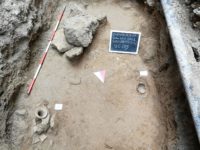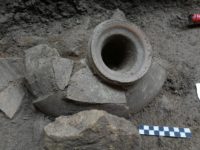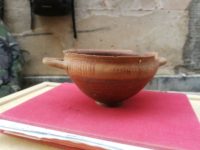 An archaic necropolis dating to the 7th century B.C. has been discovered in Gela, Sicily. It was discovered during fiber optic cable installation on the Via Di Bartolo in the historic center of the ancient town a few blocks from the sea. The excavation has unearthed two burials. One is an infant burial, the remains of a neonate placed inside a Corinthian hydria (water jug) decorated with a continuous wave motif around the rim. Even older is an intact Proto-Corinthian olpe, a footed wine jug with a long body and round mouth. It has been dated to between 700 and 650 B.C., the first decades of the founding of the Greek colony. The remains of a large animal, butchered and cooked in a funerary rite, were found near it.
An archaic necropolis dating to the 7th century B.C. has been discovered in Gela, Sicily. It was discovered during fiber optic cable installation on the Via Di Bartolo in the historic center of the ancient town a few blocks from the sea. The excavation has unearthed two burials. One is an infant burial, the remains of a neonate placed inside a Corinthian hydria (water jug) decorated with a continuous wave motif around the rim. Even older is an intact Proto-Corinthian olpe, a footed wine jug with a long body and round mouth. It has been dated to between 700 and 650 B.C., the first decades of the founding of the Greek colony. The remains of a large animal, butchered and cooked in a funerary rite, were found near it.
The trench is small, but in addition to the two notable ceramic artifacts, it is replete with remains of Proto-Corinthian, Corinthian and Attic pottery. About 20 ceramic pieces have been identified as Fikellura ware, produced in Rhodes between 560 and 495 B.C. This suggests the necropolis was extensively used over a significant period of time.
Gela was founded by Greek colonists from Rhodes and Crete in 688 B.C. on the southwestern coast of Sicily. It was destroyed by Carthaginian general Himilko in 405 B.C. and he was thorough about it, demolishing the Doric acropolis, the Temple of Athena and two other temples on the hill overlooking the gulf and setting the city on fire.
 After Himilko’s defeat of the Greek colonies of Sicily, Gela’s population was allowed to return, but the city became a vassal of Carthage, forbidden to rebuild its walls and forced to pay tribute. It would be liberated only in 339 B.C. when Timoleon of Corinth surprised even his own soldiers by routing the vastly superior numbers of the Carthaginian army (Plutarch put it at 70,000 to 6,000). Parts of the wall from the 4th century B.C. reconstruction still stand in Gela today, the only surviving example of a Greek defensive wall with a section of raised raw brick. Gela was destroyed again in the late 3rd century B.C. by either the tyrant of Agrigento or the one of Syracuse, and this time it wouldn’t recover until the modern city was founded west of the ancient one in the 13th century.
After Himilko’s defeat of the Greek colonies of Sicily, Gela’s population was allowed to return, but the city became a vassal of Carthage, forbidden to rebuild its walls and forced to pay tribute. It would be liberated only in 339 B.C. when Timoleon of Corinth surprised even his own soldiers by routing the vastly superior numbers of the Carthaginian army (Plutarch put it at 70,000 to 6,000). Parts of the wall from the 4th century B.C. reconstruction still stand in Gela today, the only surviving example of a Greek defensive wall with a section of raised raw brick. Gela was destroyed again in the late 3rd century B.C. by either the tyrant of Agrigento or the one of Syracuse, and this time it wouldn’t recover until the modern city was founded west of the ancient one in the 13th century.
Because so little archaeological material exists from before Himilko’s sacking of the town, there has been some debate among historians about where exactly the earliest settlements were located. Some have hypothesized that they dotted the surrounding area, that the center of the Classical-era (5th c. B.C.) city on the west side of the hill overlooking the gulf was a later development. The discovery of a necropolis dating to the first decades of the founding of city under the shadow of the hill indicates that the Classical Gela grew up and around the nucleus of the archaic settlement.
 A later Greek necropolis was found in the neighborhood at the beginning of the 20th century. The chamber tombs were separated by large blocks of tufa. A large block of tufa was also found in the recently unearthed burial ground. It’s possible it was used a boundary stone between the older necropolis and the newer one.
A later Greek necropolis was found in the neighborhood at the beginning of the 20th century. The chamber tombs were separated by large blocks of tufa. A large block of tufa was also found in the recently unearthed burial ground. It’s possible it was used a boundary stone between the older necropolis and the newer one.
The company installing the cable — Open Fiber — has expressed willingness to enlarge the excavated area to explore the founders’ necropolis more fully.
Not at all related but I just feel strongly compelled to thank you for maintaining this blog for all of these years. I’m a freshman in college but I’ve been reading since about 5th grade. Though I definitely haven’t consistently kept all of these years I always end up drifting back, and am endlessly impressed with the amount of care you put into these posts (how you always manage to always find such high res images is a mystery to me). Please never stop!
Best
Fran
Herodotus from 440 BC reads in Bk. VII, 153: “…now the ancestor of this Gelon, he who was at Gela as a settler, was a native of the island of Telos [to the West of Rhodes], which lies off Triopion; and when Gela was founded by the Lindians from [the eastern coast of] Rhodes and by Antiphemos, he was not left behind [in Lindos]. Then in course of time his descendants became and continued to be priests of the mysteries of the Earth goddesses, an office which was acquired by Telines one of their ancestors…”
———–
…τοῦ δὲ Γέλωνος τούτου πρόγονος, οἰκήτωρ ὁ ἐν Γέλῃ, ἦν ἐκ νήσου Τήλου τῆς ἐπὶ Τριοπίῳ κειμένης· ὃς κτιζομένης Γέλης ὑπὸ Λινδίων τε τῶν ἐκ Ῥόδου καὶ Ἀντιφήμου οὐκ ἐλείφθη. ἀνὰ χρόνον δὲ αὐτοῦ οἱ ἀπόγονοι γενόμενοι ἱροφάνται τῶν χθονίων θεῶν διετέλεον ἐόντες, Τηλίνεω ἑνός τευ τῶν προγόνων κτησαμένου τρόπῳ τοιῷδε.
———–
When I visited the Akropolis of Lindos myself a couple of years ago, there was a sign at the very top indicating that apparently ‘marvelous things‘ had been excavated, but it ‘all had been shipped off to Istanbul’ 😆